If you are the parent of an Australian citizen, an Australian permanent resident or an eligible New Zealand citizen and you are researching how you can spend more time in Australia with your children and grandchildren, you might be surprised by the number of options available.
The range of options include:
- Visitor visas
- Parent visas
- Contributory Parent visas
- Investor Retirement visas
- Skilled or employer sponsored visas
- Business, Innovation and Investment visas
- Long Stay visitor visas for parents (hopefully available by the end of this year)
- Student visas! Many colleges and universities embrace mature aged students keen to study the subject they had always dreamed of studying before life got in the way!
Some parents will inevitably have more visa options available to them than others and may be able to include their dependent children in their application.
Some Important Things to Consider
There are visas that allow you to live in Australia on a temporary basis and visas that allow you to live in Australia as a permanent resident. The type of visa you hold can impact on many aspects of your life, including:
- Pensions
- Access to Medicare and the cost of health care in Australia if you hold a Bridging visa
- Access to aged care and the cost of aged care in Australia if you hold a Bridging visa
- Access to social security benefits
- Work rights. Will you need to work to support yourself in Australia?
- Income tax and capital gains tax
- Buying or renting a property in Australia. Some temporary residents with valid visas, including bridging visas, are permitted to purchase an established dwelling to live in. Please visit the Foreign Investment Review Board website: http://firb.gov.au/real-estate/ for more information
Before you commit to a particular visa pathway, especially where the parent and contributory parent visas are concerned, it’s important to consider all of the above.
Visitor Visas
Lots of parents come to Australia on holiday to visit family, often in the warmer summer months. Some parents stay for a few weeks and some stay for a few months. It’s important to choose a visa that provides greater flexibility if you want to stay longer than 3 months. Although it is illegal to work in Australia as the holder of a visitor visa, you are permitted to work as a genuine unpaid volunteer, but only if an Australian resident would not otherwise be paid to do the work. You can also be reimbursed for out-of-pocket expenses such as meals and accommodation.
See: https://www.border.gov.au/Trav/Visi/Visi to read about the options available.
Parents and Bridging visas
There are currently six different types of parent visa. Three can be applied for from overseas or in Australia. The three visas for “Aged” parents MUST be applied for within Australia.
The “Aged” parent visas are for parents over the Australian retirement age. These parents will be granted a Bridging visa enabling them to live in Australia whilst their parent visa application is being processed. Bridging visas can be complicated little beasts and it’s important to understand what you can and can’t do on a Bridging visa. Your Bridging Visa Grant Notice will tell you what you can and can’t do and it’s really important to read your Bridging Visa Grant Notice very carefully. Parents will usually be able to work on their bridging visa – if they want to!
The diagram below highlights some important differences between the different visas.
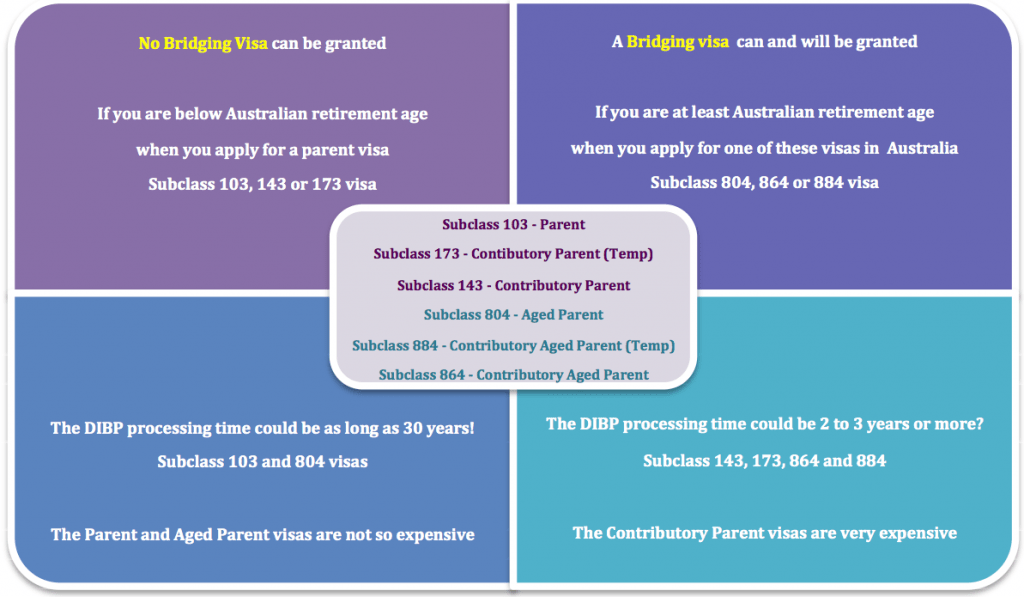
The Australian financial year runs from 1st July to 30th June. The Australian government can grant up to 1500 Parent visas/Aged Parent visas and up to 7175 Contributory Parent visas in the 2017/18 financial year. That’s 8,675 parent and contributory parent visas altogether. Many more people apply than available places, which is why the queues keep getting longer. Parent visa applications should be planned well in advance!
All parent visa applicants are required to meet the “balance of family test.” The diagram below highlights some of the things to think about when considering whether you meet the test.
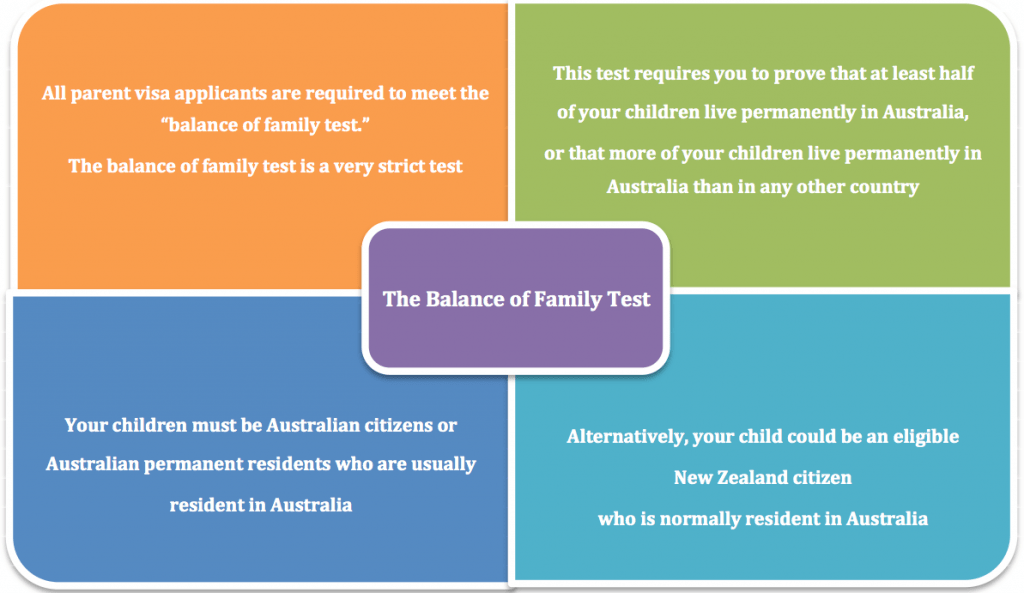
Parents and Sponsors
All parents must be sponsored and the sponsor will usually be your adult child who is living permanently in Australia.
Parents and the Assurance of Support
Parents must have an assurer who will provide an Assurance of Support. An Assurance of Support is a legally enforceable document that requires the assurer to repay any recoverable social security payments that the parent(s) may receive during their first years living in Australia. The Assurance of Support period will be 2 years or 10 years depending on the type of parent visa you are applying for. Payment of a Bond is also required – for 2 or 10 years.
The Six Options – Parent Visas
There are six different types of parent visa. Each visa has a slightly different set of rules, but all visas require parent visa applicants to have child living in Australia PLUS a sponsor PLUS they must meet the balance of family test PLUS meet the health and character requirements.
The fees shown below are in Australian dollars and will usually increase on 1st July of each year.
Option 1 – Parent (Migrant) (subclass 103) visa
This visa is usually applied for by “younger” parents under the Australian retirement age.

Option 2 – Aged Parent (Residence) (subclass 804) visa
This option is for elderly or “aged” parent visa applicants who have reached the Australian pension age. Please see https://www.dss.gov.au/seniors/benefits-payments/age-pension for more information.
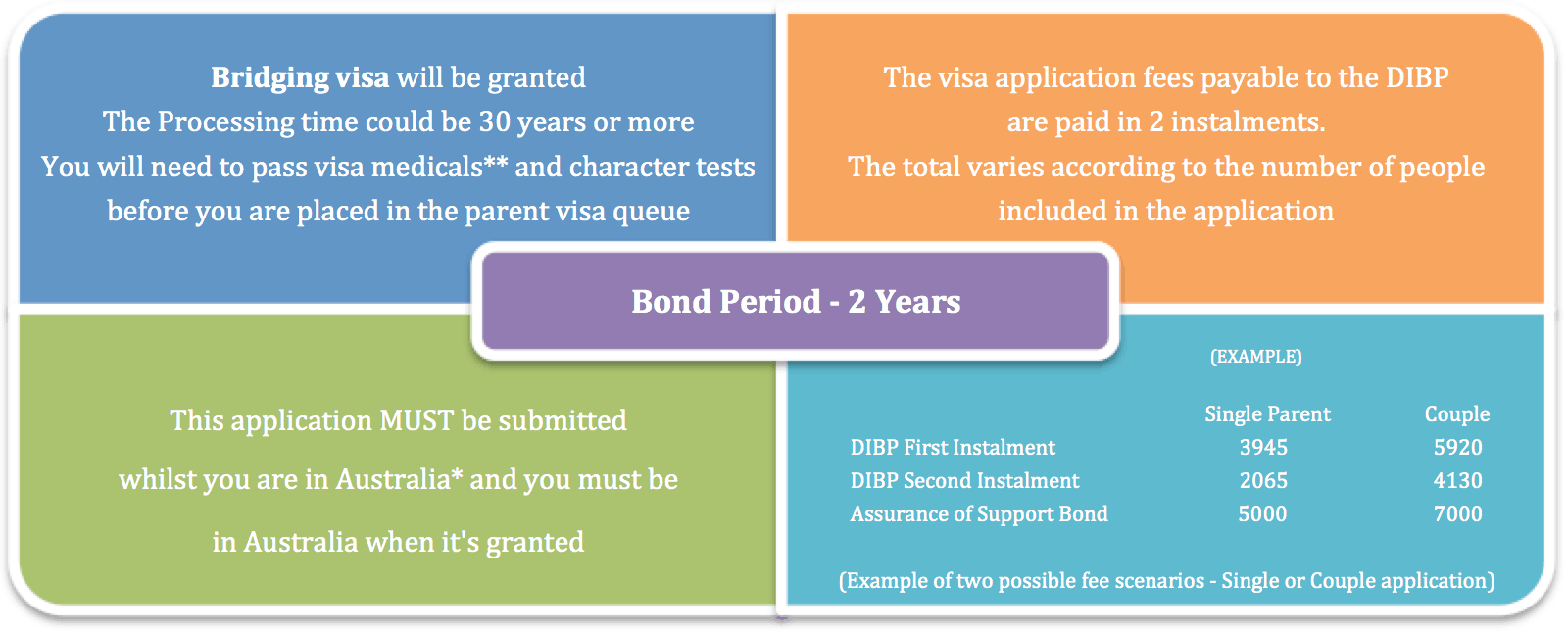
Option 3 – Contributory Parent (Temporary) (subclass 173) visa
This option is for parents who want to apply for a Contributory Parent visa but prefer to apply in 2 stages in order to spread the high visa application costs across several years. The net costs of the two-stage process is reasonably similar to the option of applying directly for a permanent Contributory Parent category visa except that the costs are effectively spread across two applications and several years. It’s important to understand that the fees payable to DIBP are based on the charges in place at the time that the application is made.
This temporary visa expires 2 years after the visa grant date. This means that a parent must usually apply for the Contributory Parent (Residence)(subclass 143) visa and pay an additional set of fees within 2 years of their visa grant date if they want to stay in Australia. There are some exceptions and our team can discuss the exceptions with you where appropriate.
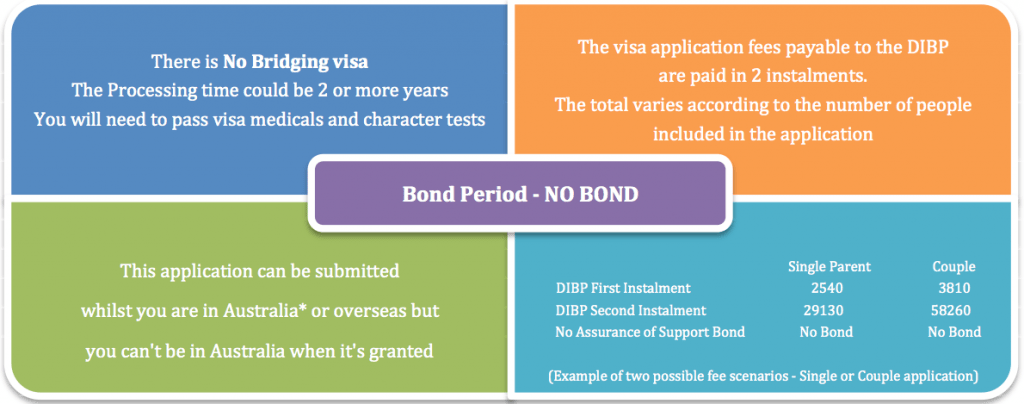
Option 4 – Contributory Parent (Residence) (subclass 143) visa
This option is for parents who:
- already hold the temporary subclass 173 visa and want to apply for permanent residence, OR
- are still under the Australian retirement age and prefer not to apply for the temporary visa.
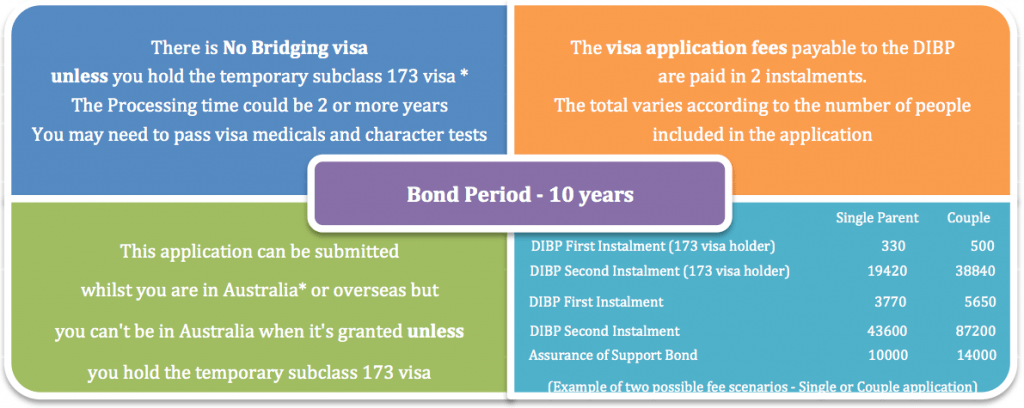
Option 5 – Contributory Aged Parent (Temporary) (subclass 884) visa
This option is for parents who want to apply for a Contributory Aged Parent visa but prefer to apply in 2 stages in order to spread the high visa application costs across several years.
This temporary visa expires 2 years after the visa grant date. This means that a parent must apply for the Contributory Parent (Residence)(subclass 864) visa and pay an additional set of fees within 2 years of their visa grant date if they want to stay in Australia. There are some exceptions and our team can discuss the exceptions with you where appropriate.
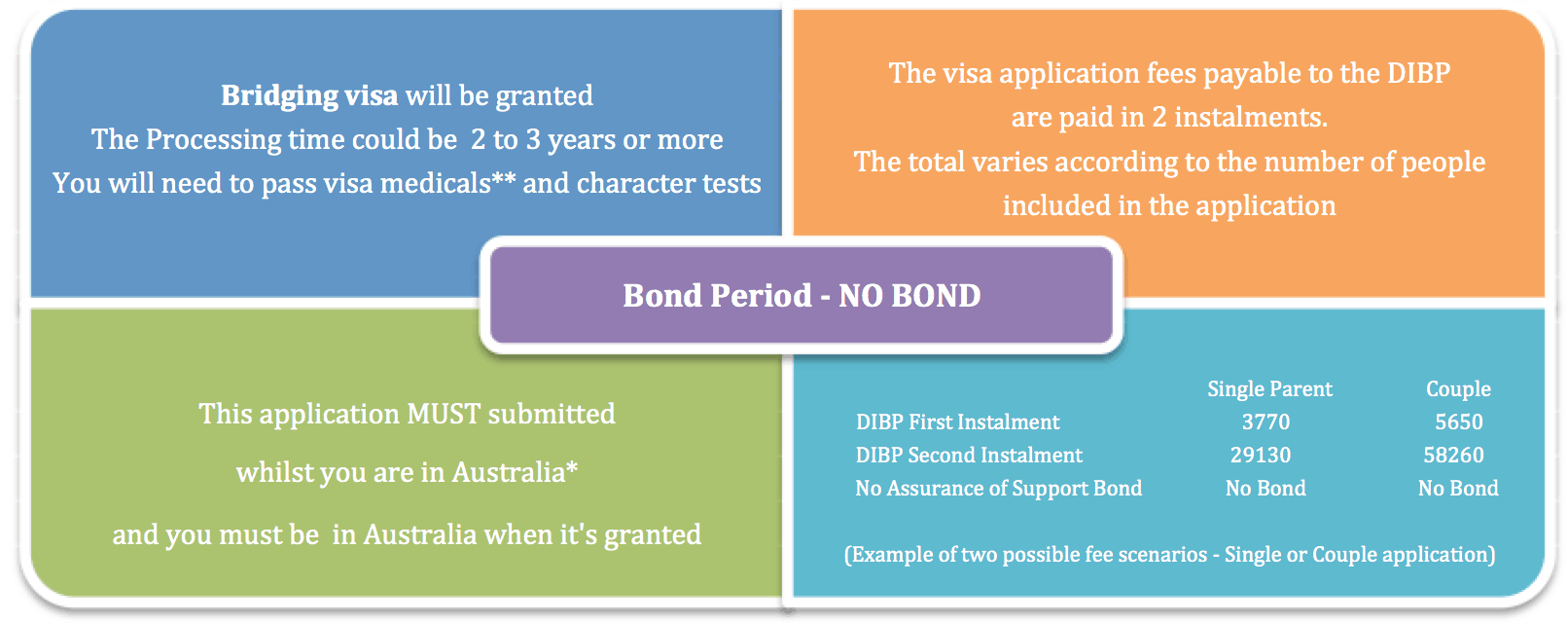
Option 6 – Contributory Aged Parent (Residence) (subclass 864) visa
This option is for parents who:
- already hold the temporary subclass 884 visa and want to apply for permanent residence, OR
- are at least the Australian retirement age and prefer not to apply for the temporary visa first. Lots of parents prefer to apply directly for permanent residence, especially where they hope to become an Australian citizen one day.

* If a parent is in Australia and they have a “No Further Stay” condition 8503, 8534 or 8535 on the visa they hold (or last held) they won’t be able to apply for any type of parent visa application whilst they are in Australia.
What if you fail the visa medical and your application is refused?
If you apply for a permanent partner visa (Aged Parent or Contributory Aged Parent) in Australia and you or your partner fails the visa medical and is unfit and unable to leave Australia on their own, there may be other visa options available, depending on your circumstances. Our team is experienced in dealing with clients with a wide range of medical issues.
The above information provides a snapshot only of the available parent visa options. We deal with lots of parent visa applications and we’ve only ever had one application refused. This was because an elderly and very frail gentleman failed the visa medical. Fortunately, with our help and support, the elderly gentleman was allowed to remain in Australia with his family.
Investor Retirement visa (subclass 405)
This is a temporary visa that does not provide a pathway to permanent residence. The visa is for self-funded retirees who are at least 55 years of age and have no dependent children. The visa can also be useful for parents who do not meet the balance of family test.
The visa applicant needs a solid retirement income (at least $50K per annum) and a huge chunk of money (at least AUD $500,000) to lock away in a designated government investment for at least 4 years. The visa application fees start at AUD $330, which may seem modest but it’s not a cheap visa. Our team can provide more information if this visa is of interest to you.
You will need State or Territory nomination.
Skilled visas
Younger parents may be eligible to apply for a skilled visa. We have created some useful skilled migrant self assessment tools and popped them on our website AND they are free to use!
- http://easivisa.com/quiz/points-test/
- http://easivisa.com/visa-resources/
- http://easivisa.com/visa-eligibility-list/ (A searchable combined MLTSSL and STSOL)
Business, Innovation and Investment visas
The business innovation and investment visas are generally for high net worth individuals who have done well in business and/or manage their own significant investment portfolios. There are 5 different visa streams and the eligibility rules are complex.
Of the 5 visa streams, we believe the Investor stream provides the most stress free pathway to permanent residence for eligible visa applicants. This visa stream can provide a useful pathway to permanent residence for younger affluent parents who don’t meet the balance of family test.
Parents would generally be under 55 years of age, have net business and personal assets of at least AUD $2.5M, including a qualifying business or eligible investments worth at least AUD $1.5M and be able to meet lots of other visa requirements, including depositing a minimum of AUD $1.5M in State or Territory Treasury Bonds for at least 4 years.
There are other investor options too, if you have a spare AUD $5M or AUD $15M and there are no fixed age limits. We can help you explore the business and investor visa options available to you, which will include a detailed analysis of your eligibility to apply for one of these visas.
Long Stay visitor visas for parents (hopefully available by the end of this year)
The Australian government is about to introduce Long Stay visitor visa options for parents. These options are going to be expensive and we’ve been told that parents may be required to pay for Australian private health insurance “up front ” to cover the whole of their stay, which could be a huge financial outlay. The eligibility rules for this visa will be complex and it looks like the rules will include the following:
- There will be a sponsorship application which must be approved before a visa application. can be made.
- The sponsor must be an Australian citizen, Australian permanent resident or eligible New Zealand Citizen.
- The sponsor must have lived in Australia for at least 4 years.
- The sponsor’s income and character will be assessed.
- A parent will pay AUD $10,000 for a 5 year visa and AUD $3,000 for a 3 year visa (each).
- A parent will be apply for this visa more than once and will be able to stay for a maximum of 10 years in total.
- Parents will have NO WORK RIGHTS but will be able to help care for their grandchildren.
At this stage, we do not know whether parents will be permitted to submit another type of visa application in Australia as the holder of this Long Stay visitor visas (for parents).
Student visas
Healthy numbers of mature aged people decide to go back to college or university in their forties, fifties, sixties and seventies to study the subject they had always dreamed of studying before life got in the way! In fact, the mother of one of the writer’s friends recently completed a Bachelor’s Degree at Curtin University and has just commenced her Master’s – at the ripe old age of 83!
Studying can be a great option for the young and also for the young at heart! Student visa holders have work rights too … 40 hours a fortnight in term time and full-time in the holidays.
When you apply for a student visa, you need to satisfy the DIBP that you are a genuine student and you may need to explain how the course is going to enhance your life. If you are struggling to understand your grandchildren’s obsession with Information Technology and want to keep ahead of the game, you could always consider studying Information Technology at TAFE as an international student. There is so much you can achieve when you have the time and energy!
So what’s next?
If you’d like to know whether you are eligible to apply for any of the above visa types, you can engage an experienced Australian registered migration agent to evaluate your situation and provide you with an advice letter setting our your options OR you can conduct your own research on the Department of Immigration website: www.border.gov.au
An experienced migration professional may be willing to undertake a free assessment of your visa options where the facts of your case are straightforward, but writing an advice letter takes time and they will probably need to charge for providing a detailed written advice, in the way that other professionals do.
We are happy to discuss your visa options over the telephone. Where we feel that you may be able to meet the eligibility requirements for a particular type of visa, we will tell you so and offer to undertake an eligibility assessment that will include a written advice. Our fee is usually $150 to $250 (plus GST) or sometimes it’s free. It all depends on the level of complexity. If your situation is complicated, we may charge more but we will always agree the fee up front. If you subsequently engage us to manage your visa application, we will always knock the $150 to $250 paid off our professional fees. Our fees can be viewed at: http://easivisa.com/pricing/
If you would like to explore your options Contact Us Today
